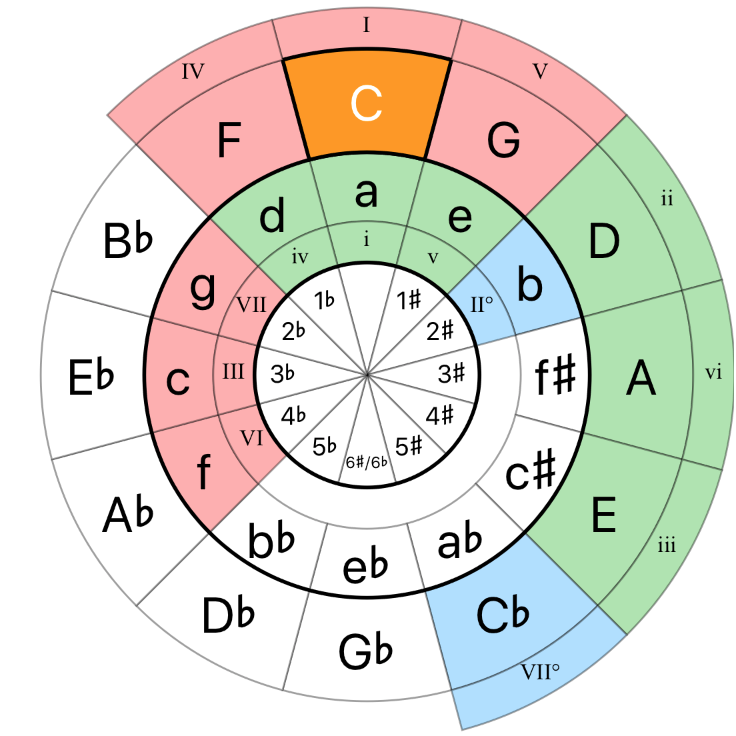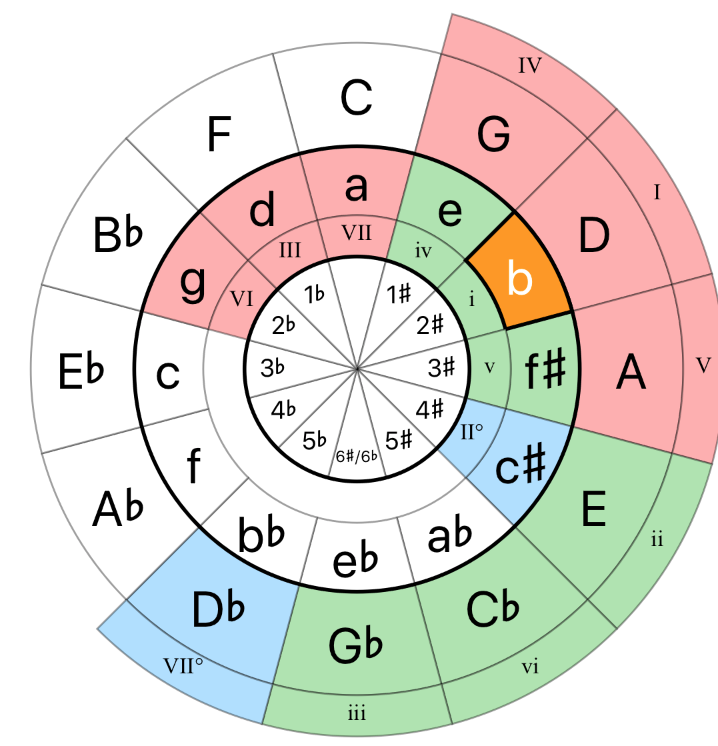In music theory, one of the most valuable tools for musicians, songwriters, and composers is the Circle of Fifths. This simple yet powerful diagram shows the relationship among the 12 tones of the chromatic scale, their corresponding key signatures, and their major and minor keys. It also serves as a guide for understanding chord progressions, modulations, and harmony. For anyone serious about music theory, mastering the Circle of Fifths is essential, as it helps in composing, arranging, and improvising music.
What Is the Circle of Fifths?
The Circle of Fifths is a circular diagram, typically divided into 12 sections, representing the 12 notes of the chromatic scale. Starting at the top, each note is separated by an interval of a perfect fifth (hence the name “Circle of Fifths”). Moving clockwise around the circle takes you up a fifth, while moving counterclockwise takes you down a fifth, or up a fourth. Each segment in the circle corresponds to a key signature—both in major and minor keys.
In addition to showing the relationships between notes and keys, the Circle of Fifths also illustrates the number of sharps or flats in each key signature, helping musicians to quickly visualize and understand how keys are constructed and related to one another.
For example, starting at C major (which has no sharps or flats) and moving clockwise, the next key is G major, which has one sharp. Continue around the circle and you’ll see D major with two sharps, A major with three, and so on. Similarly, moving counterclockwise from C major leads to F major (with one flat), B♭ major (with two flats), E♭ major (with three flats), and so on.
The Importance of Fifths in Music
The reason the Circle of Fifths is organized by intervals of a perfect fifth is that this interval plays a crucial role in Western music. The relationship between a root note and its fifth is fundamental to chord structures, scales, and harmony. For example, in a C major chord (C–E–G), the G is a perfect fifth above C. This relationship is so important that many chord progressions, particularly in classical and popular music, revolve around fifths. Progressions like I–IV–V–I (which in the key of C major would be C–F–G–C) are staples in music.
Major and Minor Keys in the Circle of Fifths
The Circle of Fifths not only shows major keys but also includes their relative minor keys. Every major key has a corresponding minor key, known as its relative minor, which shares the same key signature. For example, the relative minor of C major is A minor. These pairs are located side by side on the Circle of Fifths—C major and A minor, G major and E minor, D major and B minor, and so on.
Understanding these relationships is essential for musicians, especially when composing or arranging music. By knowing how major and minor keys interact, you can create more complex and emotionally varied pieces.
Navigating the Circle of Fifths with Piano Companion
Piano Companion, a powerful music theory tool designed for students, songwriters, and professionals alike, includes an interactive Circle of Fifths feature. This interactive tool not only displays the Circle of Fifths but also allows users to explore major, minor, and diminished chords within various scales. The color-coded system makes it easy to distinguish between major chords (highlighted in red), minor chords (green), and diminished chords (blue).
Here’s how it works:
- Major chords are marked in red, which is essential for anyone focusing on major scales and harmonies.
- Minor chords are indicated in green, allowing easy identification for those working within minor scales.
- Diminished chords appear in blue, adding another layer for advanced harmonic analysis.
The interactive nature of Piano Companion’s Circle of Fifths allows musicians to tap on any note to explore that key’s associated chords and scales. For example, if you tap on the note “C,” the Circle will highlight the C major scale and show all related chords, including the relative minor (A minor) and the chords built on other notes of the scale.
Exploring Scales Using the Circle of Fifths
One of the most useful features of the Circle of Fifths is its ability to help musicians explore different scales. In Western music, major and minor scales are the most common, but there are many others, including modes (like Dorian, Phrygian, and Mixolydian), pentatonic scales, and more. The Circle of Fifths makes it easy to see how these scales are constructed and how they relate to one another.
For instance, let’s take a closer look at the C major scale. When you select “C” on the Circle of Fifths, Piano Companion displays the C major scale, showing its notes (C–D–E–F–G–A–B). This simple scale contains no sharps or flats, making it an excellent starting point for beginners. As you explore other scales, you’ll notice how the Circle of Fifths helps you understand the structure of scales with sharps or flats.
The Circle also helps with learning minor scales. Take A minor, for example—the relative minor of C major. When you select “A” on the Circle of Fifths, Piano Companion will display the A minor scale (A–B–C–D–E–F–G), which shares the same notes as C major but starts on A. This type of relationship exists for all major and minor keys, and the Circle of Fifths helps you visualize and understand these connections.
The Circle of Fifths shows that the following chords are major for C Major: F (IV), G (V).
These chords are minor chords for C Major: D (ii), A (vi), E (iii).
And the last chord Cb (VIIo) is diminished chord.
The parallel minor key is A Minor.
Roman Numerals and Chord Progressions
Another important feature of the Circle of Fifths is its ability to illustrate chord progressions, one of the cornerstones of songwriting and music composition. In traditional music theory, chords are often represented by Roman numerals based on their position within a scale. For example, in the key of C major, the tonic chord (C major) is represented by I, the subdominant (F major) is IV, and the dominant (G major) is V.
Piano Companion’s Circle of Fifths makes these relationships easy to understand by showing the Roman numerals associated with each chord in the scale. When you select a key, such as C major, the Circle highlights the chords in that key and labels them with Roman numerals. This helps you quickly identify common chord progressions like I–IV–V or ii–V–I, which are used in countless songs across many genres.
Let’s tap on the B Minor scale:
You can see that Minor chords for B Minor are: e (iv), f# (v).
The Major chords for B Minor are G (VI), D (III), A(VII).
The last chord is Diminished C# (IIo).
If you want to lock the selected scale and would like to navigate through chords of the selected scale then tap on and after that just tap on a chord:
Practical Applications of the Circle of Fifths
The Circle of Fifths is more than just a theoretical tool—it has many practical applications for musicians of all levels. Here are a few ways it can be used:
- Composing Music: By understanding how keys and chords relate to one another, you can create more interesting and varied compositions. The Circle of Fifths can help you choose chords that work well together and explore different harmonic possibilities.
- Modulating Between Keys: Modulation is the process of changing from one key to another within a piece of music. The Circle of Fifths makes it easy to see which keys are closely related and therefore easy to modulate between. For example, if you’re in the key of C major and want to modulate to a new key, G major (one fifth above C) is a natural choice because it shares many of the same notes and chords.
- Learning and Memorizing Key Signatures: One of the most basic uses of the Circle of Fifths is to memorize key signatures. By visualizing the number of sharps or flats in each key, you can quickly recall the key signature for any major or minor key.
- Improvisation: For musicians who enjoy improvising, the Circle of Fifths is an excellent tool for creating harmonic progressions on the fly. Understanding how different keys and chords relate to each other allows you to move seamlessly between chords and scales during a performance.
Conclusion
The Circle of Fifths is a foundational concept in music theory that offers countless benefits for musicians, from beginners to advanced composers. By showing the relationships between notes, keys, chords, and scales, it helps musicians understand the structure of music and unlock creative potential. Whether you’re learning to play an instrument, composing music, or improvising, the Circle of Fifths is an invaluable tool for developing a deeper understanding of harmony, chord progressions, and key relationships.
With Piano Companion’s interactive Circle of Fifths, you can explore these relationships in a user-friendly way, making it easier to visualize how music theory applies to real-world playing and composition. Whether you’re exploring major, minor, or diminished chords, or experimenting with modulation and chord progressions, the Circle of Fifths provides a roadmap for your musical journey.
Other resources:


